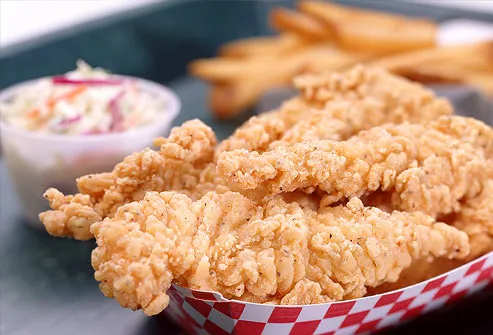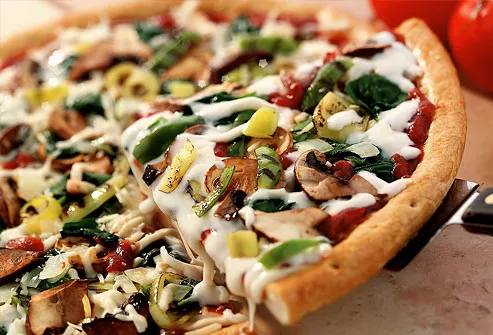Everybody loves eating out and there's not reason why you shouldn't - except the fact that most restaurant-foods are high in fat, salt, sugar or calories in general!
New health care legislation in the States will require (some time during this 2011) that big restaurant chains indicate how many calories each of their food items contains; however, it's not always possible to get the information you want.
- Some fats are good for you while other are not - Monounsaturated fats, such as those found in avocados, nuts, olives and olive oils, can help lower your LDL and maintain your HDL and polyunsaturated fats in vegetable oils, fish, mixed nuts, edamame and seeds could help decrease your cholesterol in general. So ordering grilled seafood when you go out will offer you taste, heart healthy benefits and omega 3 fatty acids. Meanwhile, the fats you should be aware of are trans fats, saturated fats and cholesterol. These are found in greasy cheeses, palm oil, coconut oil, shortenings, butter, creamy sauces, stuffed with cheese, meats and whole dairy products. Fried foods are the main concern here. Foods that are labeled as "golden crispy" to induce your mouthwatering appetite are fried with trans/saturated shortenings, ghee (clarified butter) or lard (pork fat) that will in return make your blood cholesterol spike!
- To make foods more palatable, salt (sodium) is the key. Restaurant foods can be very high in sodium. Now whether or not you are medically required to decrease your sodium intake because of high blood pressure for instance, research has shown that a low sodium diet can benefit any healthy youngster. However, the point here is to know how to spot high sodium foods. Foods that are pickled, creole sauce, smoked, marinated, teriyaki sauce, soy sauce, cocktail sauce, bacon, MSG (monosodium glutamate) added to meats or Chinese foods to give them their umami taste and canned foods are all high in salt. Therefore, don't add any table salt, ask your food to be done without extra salts and learn how to spot salty ones.
- Most restaurants label foods with extra symbols on the side: All you have to do is look for "Heart-healthy" or "Light" symbols: these are usually a red heart, a green butterfly, etc. These offer low fat, low salt and low cholesterol items making it easier for you to know which foods are the best to choose from. Watch out not to mistaken them with flags symbolizing most popular food choices.
- Don't be afraid to ask how the food is prepared and what ingredients are used. Tell your server that you are staying away from high caloric foods, high fatty/salty ones and ask for special requests for a lighter version of that meal. You can ask the chef to prepare foods using less oil, no butter, less sugar, less syrups, less salt, you name it! It's actually easy to be done so go for it next time you're eating out. You can also ask for healthier substitutions such as:
- baked potatoes instead of a side french fries order
- low fat milk instead of whole milk in your coffee
- fresh salad instead of glazed or sautteed vegetables
And if there are no substitutions, eat smart:
- peel off the chicken skin
- ask your server to skip putting fries in your plate
- skip the butter, cream, cheese, fried/sautteed vegetables, fatty fressings and dips
- know your meats: skip high fat meats, rib-eye, pork, bacon, lamb, T-bone steaks and go for leaner ones
- Ask for your sauces, dressings, gravy or dips on the side! This way you can skip them or dip less than you would have if it were already all mixed together. In addition, know which dressings to order with your salad and which not to.
- Ask for balsamic dressing, lemon-oil, light mayo, lemon, vinaigrette, citronette, mustard,tabasco, marinara with your pasta (tomatoes, garlic, onions), primavera without cream or small amounts (2 tbsps) of guacamole or low fat sour cream.
- Skip dips and dressings: heavy creamy ones such as heavy lemon, heavy vinegar, thousand island, Caesar's, cocktail, tartar, bechamel, tempura, mayonnaise and homestyle dressings.
- Know menu linguistics for healthy and unhealthy foods: Restaurants often describe foods using specific words that aim to lure your appetite while explaining how the food has been prepared.
- Watch out for: fried, batter-fried, au gratin, in cheese sauce, marinated in oil, double crust, sauteed, braised, crispy, glazed, golden, deep fried, prime, rich, buttered, buttery, breaded, creamy, beurre blanc, bearnaise, with mayonnaise sauce, creamed, escalloped, cheesy, Hollandaise, pan fried, rich in butter sauce or pan roasted.
- Whereas go for foods that are: baked, braised, cooked in its own juices, dry boiled (in wine or lemon juice), lightly sauteed, stir-fried, broiled, barbecued, roasted, boiled, grilled, poached and steamed.
- Always start with a green salad on the side, it will help make you fuller for longer. Keep in mind that peas, corn, croutons, olives, avocados, couscous, cheeses and meats could be part of a salad but are not considered as greens (which have the least calories in your meal, thus will help you make full without extra calories).
- Downsize portions: always think small. A double cheeseburger is around 600 calories while a cheeseburger is 340. Also, super fries could contain 540 calories whereas a small one accounts for 210 calories.
- Ask for whole wheat/brown/mutli-cereal breads, pasta and doughs.
- Order a thin crust pizza, no cheesy stuffings, with extra sauce, half the cheese topping, vegetables as toppings and skip the meats. Moreover, it's best if you stick to 2-3 slices max.
- Occasionally have a small portion of lighter alternatives for desserts: a scoop of diet ice cream, 1/2 cup of fruits smoothies, a cup of fruit salad, leeches and avoid high fatty, creamy and sugary ones.
- Try to decrease fluids intake with your meal. However, if you choose to have a drink go for water, unsweetened tea or sugar and alcohol-free drinks.
- Go for a small or medium portion of a meal or share a big one with a friend. Most meals nowadays are huge so don't over-indulge.





So very good tips. Thanks for sharing!
ReplyDeleteS agree will def follow...
ReplyDeleteThanks for listing the dressings, i always get cnfused!
ReplyDeleteYes it's always confusing when you have such a huge variety to choose from, im glad this post helped!
ReplyDeleteI totally agree that we should always eat the right food when dining out. Take what's necessary for our health. Thanks a lot for the tips.
ReplyDelete